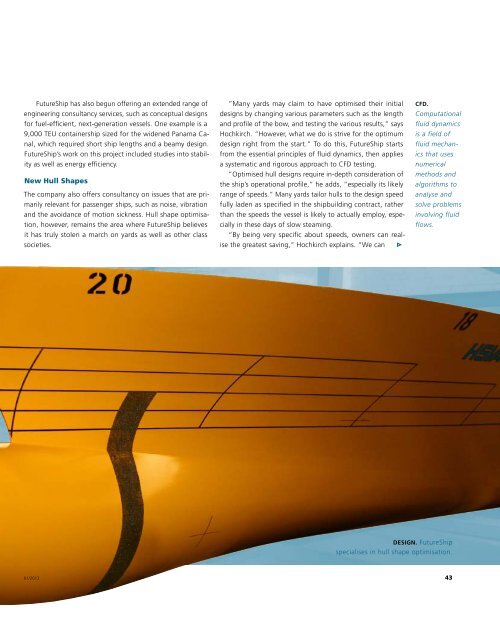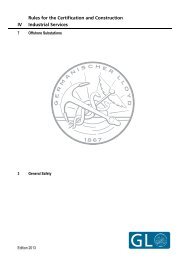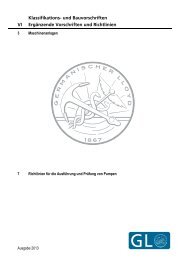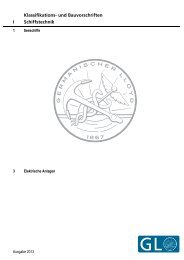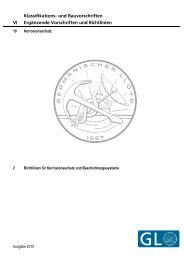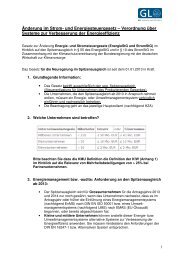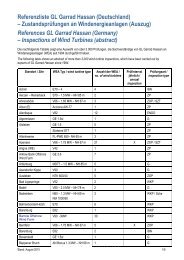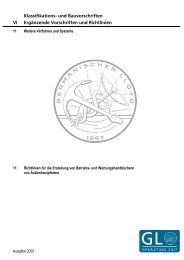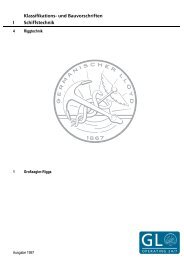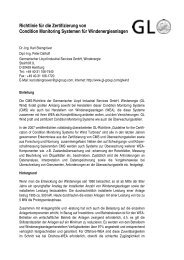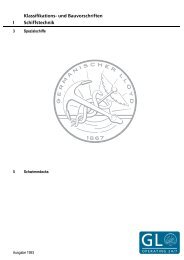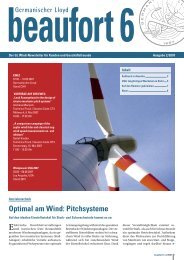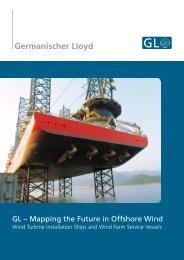Ways to Conserve Energy on Board - DNV
Ways to Conserve Energy on Board - DNV
Ways to Conserve Energy on Board - DNV
You also want an ePaper? Increase the reach of your titles
YUMPU automatically turns print PDFs into web optimized ePapers that Google loves.
FutureShip has also begun offering an extended range of<br />
engineering c<strong>on</strong>sultancy services, such as c<strong>on</strong>ceptual designs<br />
for fuel-efficient, next-generati<strong>on</strong> vessels. One example is a<br />
9,000 TEU c<strong>on</strong>tainership sized for the widened Panama Canal,<br />
which required short ship lengths and a beamy design.<br />
FutureShip’s work <strong>on</strong> this project included studies in<str<strong>on</strong>g>to</str<strong>on</strong>g> stability<br />
as well as energy efficiency.<br />
New Hull Shapes<br />
The company also offers c<strong>on</strong>sultancy <strong>on</strong> issues that are primarily<br />
relevant for passenger ships, such as noise, vibrati<strong>on</strong><br />
and the avoidance of moti<strong>on</strong> sickness. Hull shape optimisati<strong>on</strong>,<br />
however, remains the area where FutureShip believes<br />
it has truly s<str<strong>on</strong>g>to</str<strong>on</strong>g>len a march <strong>on</strong> yards as well as other class<br />
societies.<br />
”Many yards may claim <str<strong>on</strong>g>to</str<strong>on</strong>g> have optimised their initial<br />
designs by changing various parameters such as the length<br />
and profile of the bow, and testing the various results,” says<br />
Hochkirch. “However, what we do is strive for the optimum<br />
design right from the start.” To do this, FutureShip starts<br />
from the essential principles of fluid dynamics, then applies<br />
a systematic and rigorous approach <str<strong>on</strong>g>to</str<strong>on</strong>g> CFD testing.<br />
”Optimised hull designs require in-depth c<strong>on</strong>siderati<strong>on</strong> of<br />
the ship’s operati<strong>on</strong>al profile,” he adds, ”especially its likely<br />
range of speeds.” Many yards tailor hulls <str<strong>on</strong>g>to</str<strong>on</strong>g> the design speed<br />
fully laden as specified in the shipbuilding c<strong>on</strong>tract, rather<br />
than the speeds the vessel is likely <str<strong>on</strong>g>to</str<strong>on</strong>g> actually employ, especially<br />
in these days of slow steaming.<br />
“By being very specific about speeds, owners can realise<br />
the greatest saving,” Hochkirch explains. “We can<br />
CFD.<br />
Computati<strong>on</strong>al<br />
fluid dynamics<br />
is a field of<br />
fluid mechanics<br />
that uses<br />
numerical<br />
methods and<br />
algorithms <str<strong>on</strong>g>to</str<strong>on</strong>g><br />
analyse and<br />
solve problems<br />
involving fluid<br />
flows.<br />
DESIGN. FutureShip<br />
specialises in hull shape optimisati<strong>on</strong>.<br />
01/2013<br />
43


